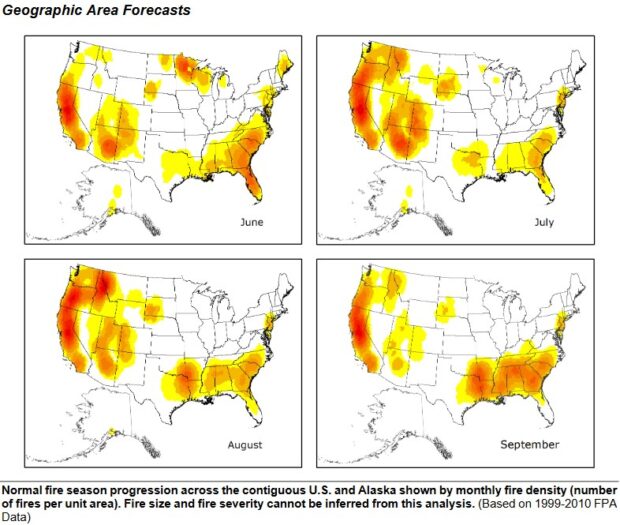The U.S. experienced a below normal number of fires and acres burned this year, according to a national agency tasked with monitoring fire activity in the nation.
Above-normal winter precipitation and snowpack slowed fuel curing across southern California, the Southwest and southern Great Basin, while consistent moisture and the absence of heat waves also contributed to the below normal fire activity, the National Interagency Fire Center reported.
Year-to-date, the number of acres burned in the U.S. is at 51 percent of the 10-year average, with a below-average number of fires (at about 82 percent of average), according to the agency’s National Significant Wildland Fire Potential Outlook for the period between June and September 2023.

Above-normal temperatures in the upper West led to rapid snow melt, while the East Coast endured below normal temperatures.
Below-normal rainfall was recorded in the Great Lakes region, the Midwest, Mississippi Valley, and some parts of the Northeast and Mid-Atlantic. Above-normal rainfall was experienced from the High Plains into most of Texas and parts of the Southwest. Florida, southeast Atlantic Coast and coastal New England also experience above average rainfall.
The Drought Severity and Coverage Index (DSCI) is now at 74 (scale 0 to 500), which is the lowest value since June 2020 and down from a 10-year peak of 202 on Nov. 1, 2022.
More than 59 percent of the country has no drought and less than 20 percent of it is in moderate to exceptional drought.
Climate predictions indicate above-normal temperatures for the West, South and East Coast through summer.
Because of an expected below-average North American monsoon season, below-normal precipitation is likely for the Southwest into the broader Four Corners region. Below-normal rainfall is also forecast along and west of the Cascades.
Above-normal precipitation is expected in parts of the Southeast, Midwest and Plains during the summer, with below-normal rainfall possible in the Great Lakes region during June and in the Northeast later this summer, the agency reported. Despite this, above-normal fire potential is expected to emerge in parts of the Great Lakes in June due to recent drying and forecast dry conditions and is likely to continue into August, expanding into portions of the Northeast by July.
Areas that may see above-normal fire potential this summer include Rangeland areas from central and eastern Washington into central and southeast Oregon, southwest Idaho, and northwest Nevada due to above-normal fine fuel loading.
Washington state will also see the likelihood of above-normal fire conditions due to recent and predicted warmer and drier conditions.
Above-normal significant fire potential in eastern and central portions of the Interior and south-central Alaska during the latter half of June and extending into July is likely, according to the U.S. fire agency.
As summer progresses, northern Idaho and northwest Montana could see above normal fire conditions, as well.
Significant wildland fire potential in the Northern Rockies Geographic Area (NRGA) from June through September is expected to be normal, except for some parts of northern Idaho and northwest Montana, where activity will be above normal starting in July and August.
Near-normal significant fire potential is also expected across most of the Eastern Area from June to September.
California and Hawaii are expected to see below-normal to normal fire activity throughout the summer.
Below-normal fire conditions are likely in June for the higher elevations in the southern Great Basin through the mountains of Utah and much of the Southwest, west of the Continental Divide, with the areas returning to near normal significant fire potential in July with the possibility to remain so depending on how the North Atlantic Monsoon Season plays out.
The Great Basin and High Sierra will see a delayed fire season, the result of a record snowpack across the southern two-thirds along with above normal winter precipitation. Nevada and southwest Idaho will see normal fire potential through June, with the possibility of higher-than-normal fire conditions in July and August and extending to Utah.
The Southern Area of the U.S. has seen widespread drought relief “with the U.S. Drought Monitor showing two to three category improvements across large parts of Texas, Oklahoma, Florida, and Virginia,” the report noted.
Lingering dryness was noted along the Gulf Coast, including the far western Florida peninsula where severe to extreme drought was still in place as of May 23, the agency said.
Because the chances of an El Niño weather pattern are good, a normal fire season is expected throughout the Southern Area from June through September.





















 Loss Uncertainty High Amid ‘Rapid Softening’: Liberty Mutual Exec
Loss Uncertainty High Amid ‘Rapid Softening’: Liberty Mutual Exec  Sentry Transformation Saves ‘Tens of Thousands of Hours’ With AI in Claims
Sentry Transformation Saves ‘Tens of Thousands of Hours’ With AI in Claims  Lemonade CEO Declares ‘Best Quarter Ever,’ Posts Narrowed Q4 Loss of $30M
Lemonade CEO Declares ‘Best Quarter Ever,’ Posts Narrowed Q4 Loss of $30M  Winter Weather Loss Prevention: A Strong ROI Opportunity for Property Insurers
Winter Weather Loss Prevention: A Strong ROI Opportunity for Property Insurers 
